Student Blog
Alyssa
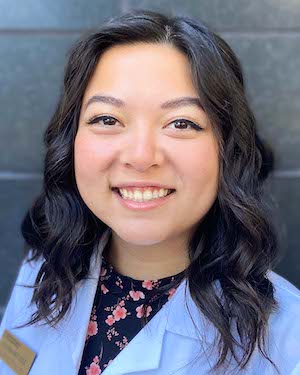
12 Weeks of Fieldwork ⟩
December 16, 2021, by Alyssa
Welcome to a special edition of student blogs! For the next 12 days, we will be sharing a blog every day. To kick us off, I’m excited to tell you about my 12 weeks of fieldwork.
Level II fieldwork is a full-time 12-week clinical experience in any occupational therapy setting. As part of the Entry-Level MA, you do two of these in the 2nd and 3rd summer. I felt set on doing one of my Level IIs in a pediatric hospital, but many of those want someone who has already done a Level II in an adult hospital setting. So here was my criteria for searching for my first Level II: (1) Adult hospital setting (2) In a new and interesting place.
That was it really. I had little sense of what I wanted to get out of working with adults. In fact, I was terrified of working with adults. I had only ever worked with children and knew I loved it, so it never crossed my mind to pursue something else.
We can request fieldwork sites anywhere in the country, so I browsed the map of sites and picked Marianjoy Rehabilitation Hospital as my top choice. No one from USC had done their fieldwork there before, but it hit both of my criteria. It is a hospital with inpatient, outpatient, and day rehab programs in Wheaton, IL, a suburb of Chicago. And luckily - I got placed there! So after a lot of scrambling to find housing in Illinois, a state I had never been to, I packed up all my stuff and moved for the summer of 2021.
Here’s what my 12 weeks looked like.
Week 1: Observation, Loneliness, Exhaustion
To start out, I experienced a combination of excitement, overwhelm, and imposter syndrome constantly for the whole week. I was thankful that my site had weekly objectives for their fieldwork students, and week 1 was mostly observation. Even so, it was hard not to freak out knowing I would be actually doing what I was watching in a few short weeks.
It was tough adjusting both to a new role as a fieldwork student and to a new city at the same time. I only knew two people in the area, all the grocery stores were different, and I felt like a foreigner. I was subletting an apartment in Chicago and commuting 45-90min to and from the hospital. My hours were 6:30am - 3pm, but I tried to get there by 6. By the time I got home around 4:30/5, I’d eat dinner and immediately get ready for bed so there was no time to socialize. In all senses, I was exhausted.
Week 2: Leaning on Other People
By week 2 I was starting to feel more comfortable with the other people at the hospital. The OT schools in the Midwest had a different schedule, so the other fieldwork students were already halfway done when I came in. The conversations I had with them were the reassurance I needed that I was going to be fine.
The other therapists, nurses, and hospital staff were incredibly welcoming. I somehow picked a random site off a map and ended up at the nicest hospital in the country. It put me at ease knowing they were used to having students around and weren’t judging me for asking questions.
Above all, my fieldwork educator could not have been a better match for my learning style. He was great at giving constructive feedback in a way that was encouraging and he boosted my confidence when I was clearly very anxious.
Week 3: Sweaty
Each floor of the hospital was sectioned into different clusters of patients. I was placed in the inpatient brain injury rehab unit, where each therapist has about 7 patients on their caseload that they see mostly every day. At this point, I was expected to take on a couple of my fieldwork educator’s patients onto my own caseload. There was a lot of sweat, but I was really enjoying getting to connect more closely with the patients.
Week 4: Getting Into the Groove
As I gradually built up my own caseload each week, I started to feel more competent in my own skills and useful as a teammate to my fieldwork educator. Plus, after 4 weeks, I had finally adjusted to my new normal of being asleep by 9pm and waking up at 5.
Week 5: Emotional Support Ice Cream
Weeks 5 and 6 looked a lot like week 4. I added about 1 new patient to my caseload each week and spent more time planning/documenting/reviewing with my fieldwork educator. Objectively, the workload was increasing, but it was a comfortable pace and I was feeling good.
I was also improving my life balance, including prioritizing meal prepping and making more time to socialize (especially weekly Bachelor/ice cream nights with friends).
Week 6: Midterm Eval
Woohoo halfway through! Anxiety no more! Just kidding. You get evaluated at the end of week 6 and I was really worried for nothing. I had been getting consistent feedback from my fieldwork educator, and the evaluation session was helpful for us to elaborate on that feedback and set goals for the second half of the summer.
Weeks 7-11: Full Caseload, Feeling like I Belong
The gradually-building-up-to-a-full-caseload part of fieldwork was over. I was still working closely with my fieldwork educator, but the goal was for me to lead all the sessions. Even though I had become more comfortable with treatment planning, the nature of brain injuries is unpredictable and you never knew what the next patient would be like — which was both challenging and exciting as an opportunity to get creative working in a hospital.
The role of a fieldwork student at this point of the experience was an unfamiliar middle ground between student and professional. Obviously, I was still learning and building my skills, but at the same time I felt like I was really in it and working. I got to collaborate with an amazing PT and SLP, my documentation required minimal review, and I got such kind comments from patients who were surprised I was a student. I really felt like I belonged.
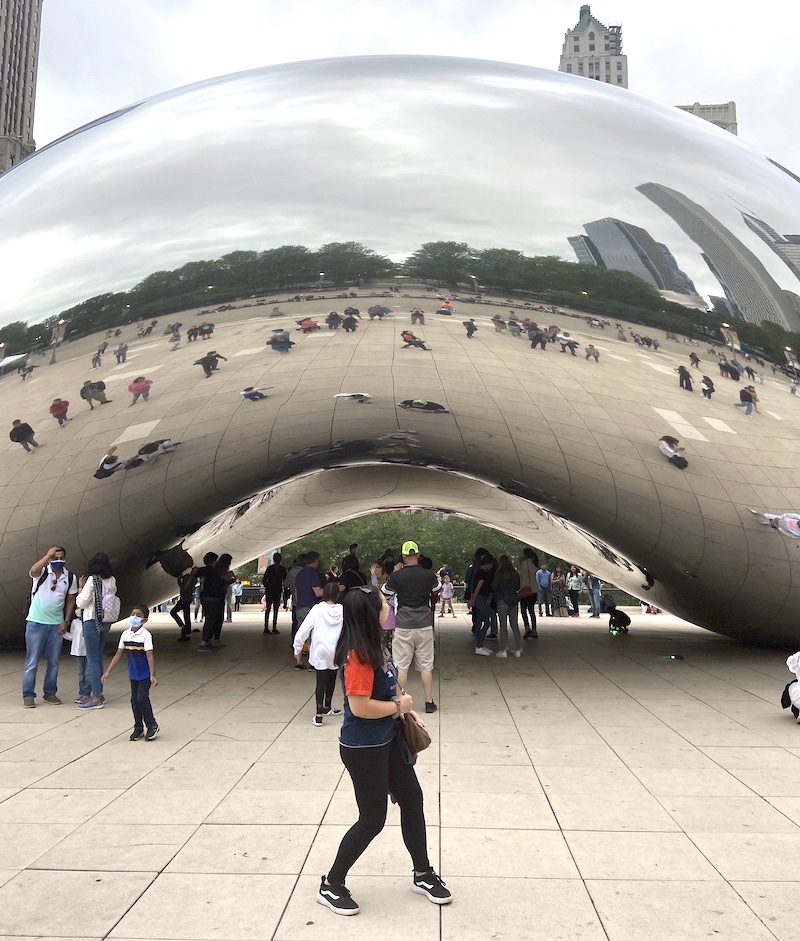
On the side, I crammed in some Chicago tourism.
Week 12: A Tearful Goodbye
I am a sprinkler when it comes to saying goodbye. On my last day, I cried on the way there, I cried saying goodbye to everyone, and I cried on my way home. I never thought I would love working in this setting so much, and it was so hard to think about it being over and going back to school for a year before my next Level II. Looking ahead, I still can’t wait to try out pediatric hospital work, but I’m happy to know there’s a part of me that likes working with adults too.
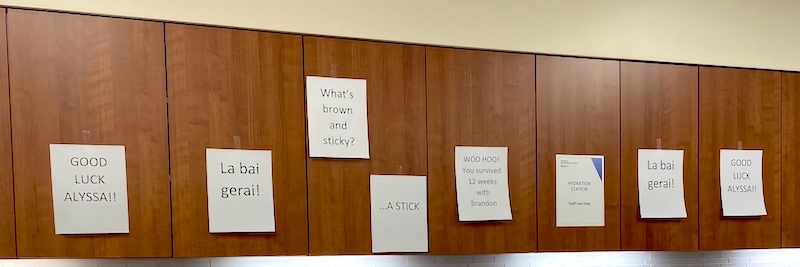
Signs up in the therapy gym for my last day with references to some inside jokes/memories from the summer.
If you’ve made it this far, thanks for reading! TLDR: My Level II fieldwork was expectedly challenging but unexpectedly awesome.
⋯

OT Dance Party ⟩
November 17, 2021, by Alyssa
I’ve been teaching Zumba at the USC Village Gym since Fall 2018. As an extrovert who struggles to prioritize exercising, it has been a win-win. I am obligated to get myself to the gym and energized from both the exercise and the social time. Especially with how challenging graduate classes can be, it is a much needed reset to my week every Tuesday.
So, what does this have to do with OT?
This week in OT 534 Health Promotion & Wellness we had a “wellness workshop” day where students got to facilitate and attend different occupation-based activity groups to promote personal wellness. When we got the sign-ups to facilitate a group, I signed up right away. Bringing Zumba to OT school!
My fellow students submitted their preferences and were assigned to different workshops to attend during class time (some of the other options were cookie baking, songwriting, and vision boarding 😮).
Given that dancing in classrooms filled with tables and chairs would not be ideal, we had to improvise for the space. We were out facing the elements on the lawn (muddy uneven grass, an unexpectedly hot November day) with a small speaker and a lot of funny looks from people walking by. But still, I had a blast, and based on all the laughing at/with me & each other, I think the participants did too. It was such a fun chance to share one of my favorite occupations with my friends, especially those who have never done it before. Dr. Cox stopped by during the workshop and thought I was putting up a “fight on ✌️” while dancing . . . truthfully I was just indicating that the move should be done twice, but hey — two birds one stone.

2nd year Entry-Level MA students participating in the Zumba workshop. Photo by Silvia Hernandez Cuellar
Even though I did not get to participate in the other activities, I loved how Wellness Workshop day highlighted how seemingly random skills could be an asset for OT’s role in health promotion. What other career path has a place for backgrounds in dance and martial arts and songwriting and cooking and crafting? I mean, OTD Resident John J. Lee even facilitated a Squid Games competition. Opportunities for wellness are everywhere — you never know what skills your colleagues will bring to the table!
⋯

A Love Letter to the OS Minor ⟩
October 27, 2021, by Alyssa
With USC course registration coming up, let’s chat about the occupational science (OS) minor and why it’s the best dang minor ever (Let’s be real — it’s part of my job to promote our programs . . . but I promise this is my honest opinion and I’d say all of this for free).
Undergrad was a very stressful time for me. My major courses involved many overlapping creatively-demanding projects, and I spent plenty of late nights glued to my computer to keep up with it all. For me, and for many others, the OS minor was a refuge. Beyond their obvious application to OT school and life in general, I thought they were all really fun and often were a stress-free few hours of my week. AND I actually remember what I learned in them. Here’s what I took & my favorite project from each class:
OT 250 (4 units): Introduction to Occupational Science and Occupational Therapy
- What is it? The only class required for the minor. It was like a sampler of everything OT has to offer — we learned about healthy habits and routines, flow, motivational interviewing, lifestyle redesign, OS research, neuroscience, stress management, sleep hygiene, creativity, exercise, sensory systems, and (still somehow) more!
- My favorite project: We wrote a paper to reflect on occupations that bring us into a flow state — I wrote mine about Zumba. 💃
OT 251 (4 units): Across the Lifespan: Occupations, Health and Disability*
- What is it? The OT department’s lifespan development class. This class was great preparation for the Team-Based Learning format used in several of the OT graduate classes. *(Bonus: it covers a prerequisite for the graduate program so it’s like a 2-for-1 deal.)
- My favorite project: Individually, our final assignment was to read a memoir by a person with a disability and relate it to the course — I applied the person-environment-occupation model to Tara Westover’s Educated and it was the first time I got to practice this kind of analysis.
OT 330 (4 units): Perspectives on the Daily Life of Families
- What is it? A class dedicated to the roles within and occupational impact of family life.
- My favorite project: A family tree diagram to identify occupational connections within our families. We could make it as extensive as we wanted, and I had a blast. My final tree was 23 pages wide 😮
OT 350 (4 units): Disability, Occupation, and the Health Care System
- What is it? Amazing guest speakers and meaningful discussions surrounding the varied experiences of living with a disability and navigating the health care system.
- My favorite project: We had weekly journals to reflect on our developing understanding of disability — my favorite journal activity was an accessibility scavenger hunt around USC’s main campus.
OT 370 (4 units): Understanding Autism: Participation Across the Lifespan
- What is it? This class was so different from psychology classes I had taken that included content about ASD. We focused on neurodiversity, lived experiences, and advocacy.
- My favorite project: My ‘media representation of ASD’ group project. I got to illustrate a children’s book and explore ways to help typically developing children understand their peers with ASD.
If I could have fit more in my schedule, I would have. Specifically, the human-animal interaction class. A few weeks ago, my friend’s dog was a guest speaker in that class — he was excellent.
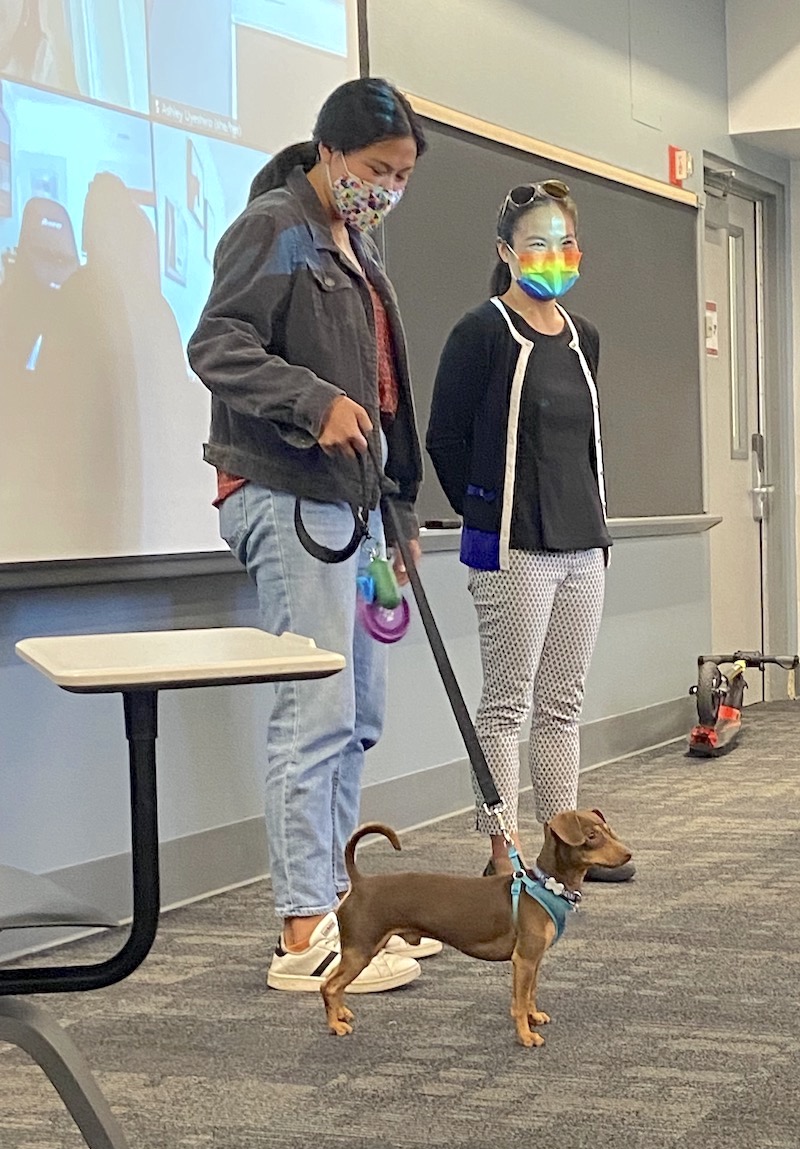
Dr. Ashley Uyeshiro Simon and guest speakers Samantha Kosai (human) and Oliver Kosai (small dog). The start of Ollie’s long career in academia, I’m sure.
As a student ambassador, I recently got to go back and give brief presentations to some of this semester’s OS minor courses, and it made me really nostalgic. When I feel nostalgic, I get emotional. When I get emotional, I write letters and never send them (usually because they are addressed to real people. Since this one is addressed to a non-sentient academic program, I’m ok with publishing it on the internet. So, here we go).
To my beloved OS minor,
I wish we could have spent more time together. I miss a lot about being an undergrad at USC, and your classes are no exception.
Thank you for classes that brightened my afternoons when I’d usually be needing a nap. Thank you for faculty mentors who have supported me through ups and downs both academically and personally (shout-outs to Linsey, Kate, & Kristy). Thank you for literally assigning some of my closest friends, Leah and Dakotah, to me as part of my group for OT 251 — they’ve stuck with me all the way til the MA-II program, and now they’re stuck with me for life.
Thank you for guiding me into the best career in the world.
✌️
Alyssa
⋯

Better Late Than Never: The MA ’22 White Coat Ceremony ⟩
October 7, 2021, by Alyssa
The White Coat Ceremony for the entry-level-MA class of 2022 felt like a long time coming. With everything moving to Zoom, many of us were concerned that our ceremony scheduled for August 2020 would also end up in the virtual void. Luckily, my class voted to postpone the ceremony instead.
Speaking honestly, I had not been looking forward to the white coat ceremony. You can’t look forward to something you didn’t know about. So at first, missing the experience did not feel like a big deal. Upon learning more about the meaning behind the ceremony as the uncertainty loomed, I felt more and more disappointed. The White Coat Ceremony is a tradition to induct and welcome occupational therapy students into the profession — what a sad thing to miss out on.
We were sent our white coats in the mail. Since we could not try on samples in person, the division had a few students from the class of 2021 virtually show us their different sizes of coats so we could make our best guesses for our sizes (as you can imagine, the accuracy of our guesses were mixed). Opening the white coat package felt like it should have been a big moment, but honestly, it felt kind of empty. I wished I was receiving it with my classmates, most of whom I had only ever seen shoulders-up in a Zoom screen box.
The limbo of if/when the ceremony was going to happen felt endless. A whole year later, in July 2021, we received the save-the-date email — it was finally happening! On a very warm late August day, under a huge tent on the lawn outside of CHP, the excitement was palpable. Dr. Rafeedie stepped on the stage 5 minutes before the ceremony even started to set up water bottles and everyone started cheering. After a hard year of online/hybrid classes and fieldwork, the class of 2022 got our in-person ceremony surrounded by our friends, family, and faculty. My voice felt croaky afterward from cheering my friends on.
I can’t speak for the rest of my class, but I think the ceremony would have felt really different if we did it at the beginning of the program. Doing it in the middle of the program was an opportunity to look back, look ahead, and look around at all of the friends and colleagues I have come to appreciate so much over the last year. It was definitely worth the wait.
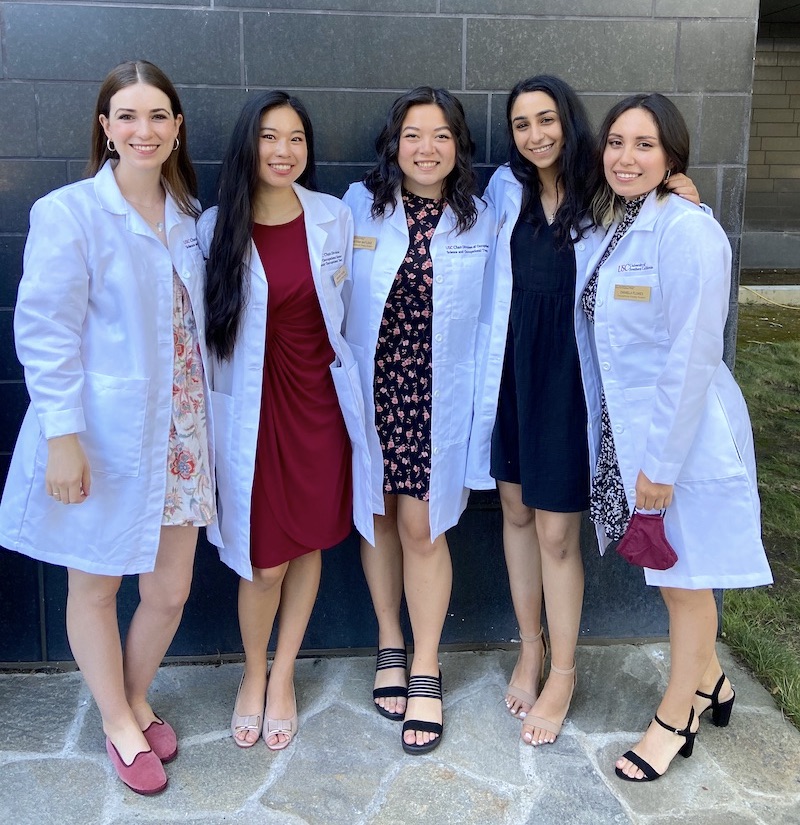
MA ’22 friends left to right: Elizabeth “Lizzo” Bowers, Maggie Young, Alyssa Matlosz, Mariamme Ibrahim, Daniela Flores
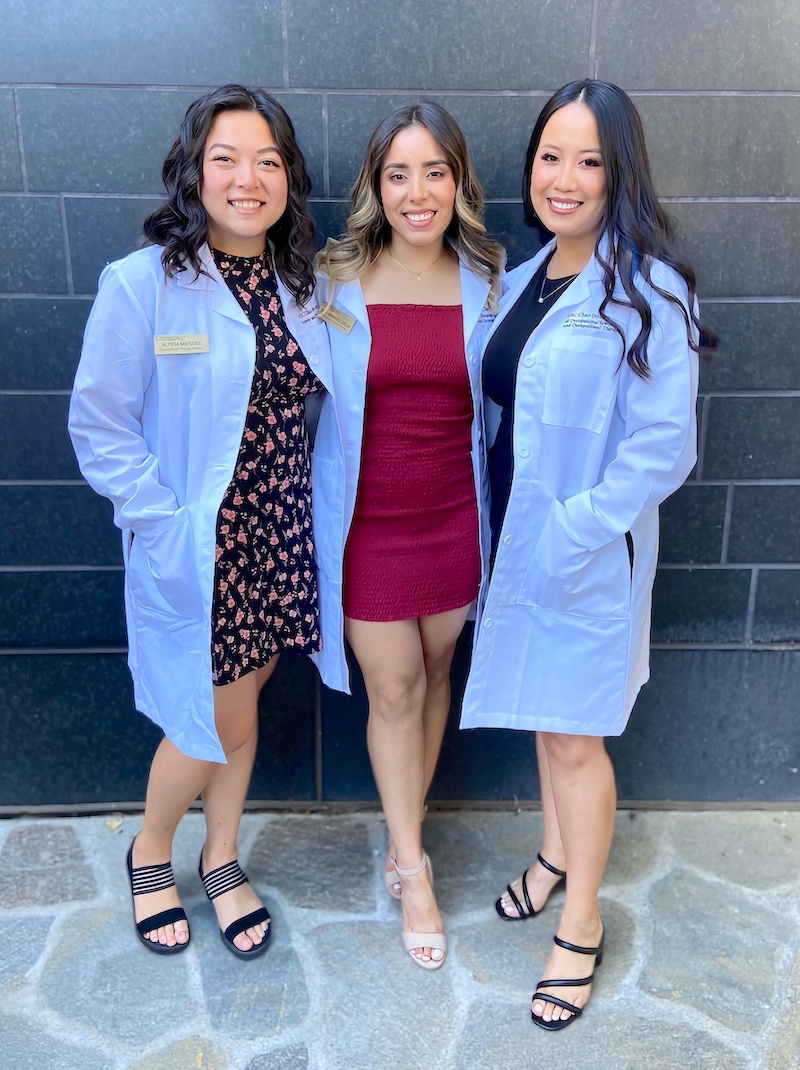
With my fellow Chan student ambassador friends Silvia Hernandez Cuellar and Teresa Pham
⋯

Hacking Houses into Homes ⟩
September 22, 2021, by Alyssa
Housing and Transportation Life Hacks Living in LA
Like a lot of people, I’ve spent most of my time over the past year and a half at home. In a series of events (some fortunate, others not so much), “home” for me has looked like a USC dorm, my childhood bedroom, and several short term apartments. Since March 2020, my living situation has been like a game of ping pong: LA → New Jersey (1 month) → Wisconsin (1 month) → New Jersey (2 months) → Connecticut (4 months) → LA (4 months) → Illinois (3 months) → LA (present).
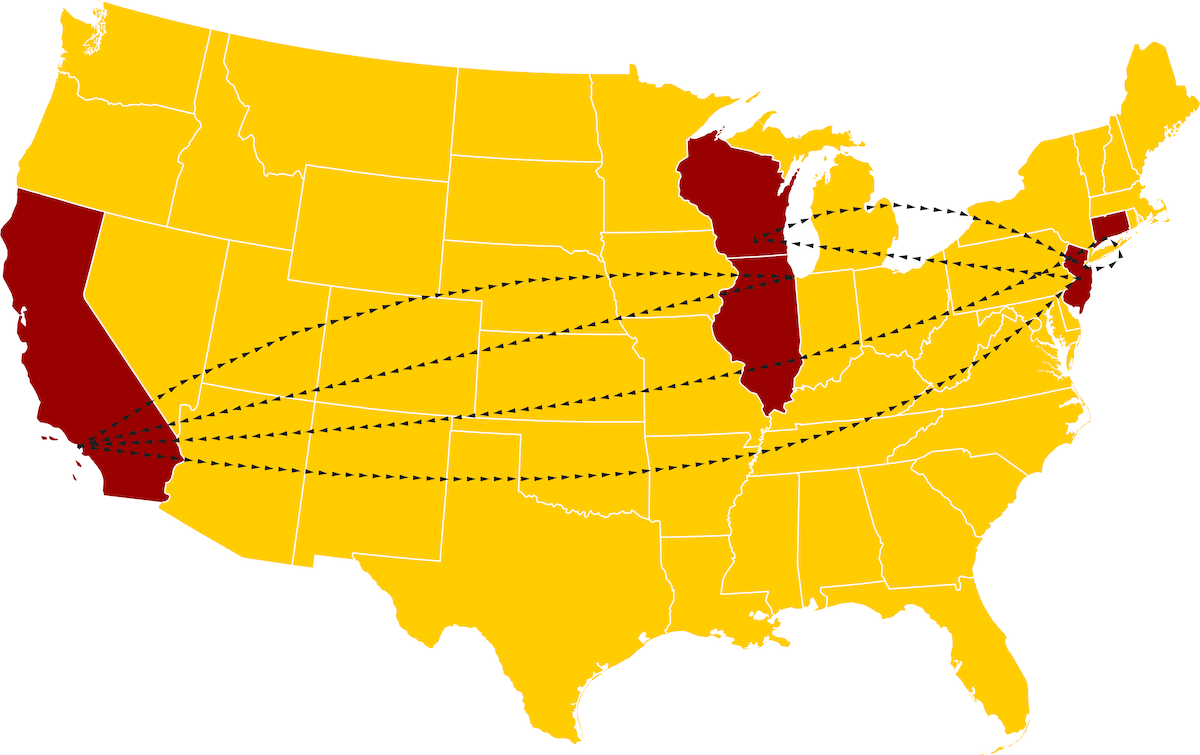
1.5 years of moving around
On top of hopping between states, I was constantly changing the spaces themselves. I can get obsessive over tetris-ing my things into a new space as logically as possible. I draw out floor plans and make models on the Sims. Then, I rearrange my house when I’m stressed (it is a hazard of living with me, any roommate of mine can attest). But what all of this moving, planning, and rearranging has taught me is that there’s no right or wrong answer for a living space — the best space is whatever works for the people living in it.
We’ve learned repeatedly in class that an environment that matches a person’s needs can support their ability to participate in occupations. If you’re considering changing your current setup, moving to LA for grad school, or trying out-of-area fieldwork in a new city — let’s talk tips for making your living environment into a home.
Locations for Leisure
Especially if you are working from home, it can be easy to forget that home is also a place for leisure. Think about how you can make space for leisure activities you like. This could be leaving floor space for a yoga mat, setting up a craft corner, or establishing a comfy space to read. For me, this means having a dedicated table to do puzzles.
Match Your Mess
Nobody’s perfect and sometimes our habits/routines are messy. Instead of shaming yourself for it, consider how your environment can support you. Here are 2 examples:
- If I don’t see something, it isn’t there. I keep my clothes easily visible stacked on bookshelves instead of hidden in drawers. In my fridge, leftovers are on the top shelf, the condiments are in the vegetable drawer, and all vegetables are in the door (this one has really saved me from wasting food).
- Part of my daily routine is trying on no less than 4 outfits before I pick one and then I either run out of time or, honestly, don’t prioritize putting them back. This used to result in a disaster zone in my bedroom and confusion between what clothes were dirty vs clean. My solution now is to have a separate basket for clothes-to-put-back-later that I can reorganize when I have time.
While these might make no sense to you, my point is that there are no rules. Match your home to your habits/routines.
Furniture is Fluid
I’ve gotten almost all of my furniture second-hand and a lot of it is not used for its intended purpose. I’ve used an IKEA dining table as a desk. We used to keep pots/pans in the TV stand. My current fruit shelf was formerly my plant stand and is actually just a bathroom rack I found on the curb. Especially if you’re moving around and feeling like arranging furniture is like fitting a circle block into a triangle hole: everything is multi-purpose if you believe it is.
DIY Decor
Filling your space with decorations that make you feel good can seem expensive. Channel your creative energy and consider making some DIY Decor (throwback to Foundations: Creativity, Craft and Activity Analysis). It doesn’t have to be fancy - here’s some of what I’ve made:

Embroidered/painted moon grid + popsicle stick shelves. All materials are from Amazon or the dollar store.
Writing this felt a little like skipping ahead. Actually finding housing, furniture, roommates, etc. is a whole other ball game — but I’ll save that for another blog post. 😊
⋯





